Themed collection Celebrating the ChemComm Emerging Investigator Lectureship Winners

Cation-controlled catalysis with crown ether-containing transition metal complexes
This Feature Article reviews the structural motifs and catalytic applications of crown ether-containing catalysts and details the development of “pincer-crown ether” ligands for applications in controlled catalysis.
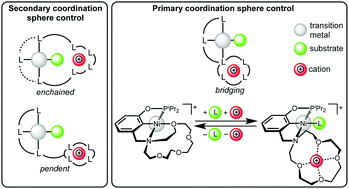
Chem. Commun., 2019,55, 5047-5059
https://doi.org/10.1039/C9CC00803A
Dimension-controlled ion-pairing assemblies based on π-electronic charged species
This feature article summarizes the recent progress in the study of ion-pairing assemblies based on π-electronic ion pairs, including anion complexes of π-electronic molecules.
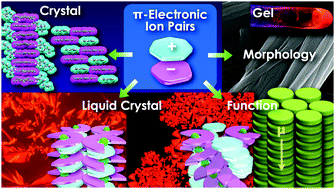
Chem. Commun., 2017,53, 2894-2909
https://doi.org/10.1039/C6CC10255G
Cooperative self-assembly of porphyrins with polymers possessing bioactive functions
This review covers recent research on design strategies for the cooperative self-assembly of porphyrins with polymers and its implementation as bioactive assembly.
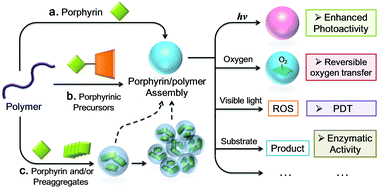
Chem. Commun., 2016,52, 13543-13555
https://doi.org/10.1039/C6CC05449H
On the outside looking in: redefining the role of analytical chemistry in the biosciences
Analytical chemistry has much to offer to an improved understanding of biological systems.
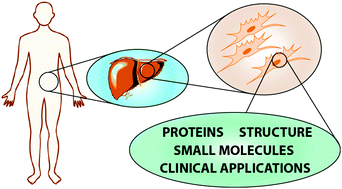
Chem. Commun., 2016,52, 8918-8934
https://doi.org/10.1039/C6CC00128A
Organic nanophotonic materials: the relationship between excited-state processes and photonic performances
Organic active nanophotonics: excited-state coupled photonic behaviours strongly determine the optical performances of organic nanomaterials. The photonic actions and related material properties can be well controlled by tailoring the intra/inter-molecular excited-state processes.
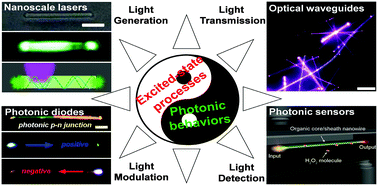
Chem. Commun., 2016,52, 8906-8917
https://doi.org/10.1039/C6CC00018E
Towards medicinal mechanochemistry: evolution of milling from pharmaceutical solid form screening to the synthesis of active pharmaceutical ingredients (APIs)
Development of mechanochemistry for API synthesis and pharmaceutical solid form screening signals the emergence of medicinal mechanochemistry – a discipline at the interface of medicinal chemistry and sustainable synthesis.

Chem. Commun., 2016,52, 7760-7781
https://doi.org/10.1039/C6CC02015A
Making C–H bonds with CO2: production of formate by molecular electrocatalysts
This article reviews the progress in the reduction of CO2 to formate using molecular inorganic electrocatalysts, with an emphasis on recent insights and successes in selective C–H bond formation with CO2 to favor formate production in aqueous solutions.
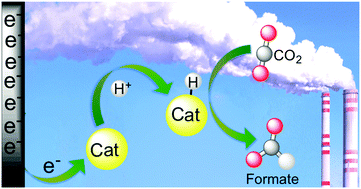
Chem. Commun., 2016,52, 1768-1777
https://doi.org/10.1039/C5CC09041E
Size dependent selectivity of Cu nano-octahedra catalysts for the electrochemical reduction of CO2 to CH4
Octahedral Cu nanocrystals in the size range of 75–310 nm are synthesized and investigated for electrochemical CO2 reduction.
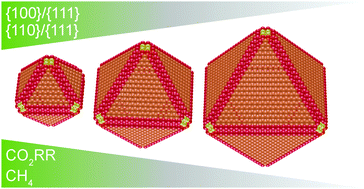
Chem. Commun., 2019,55, 8796-8799
https://doi.org/10.1039/C9CC02522G
Sensing the impact of environment on small molecule differentiation of RNA sequences
Pattern recognition of RNA with small molecules (PRRSM) reveals the impact of environmental conditions on the differentiation of RNA structures.
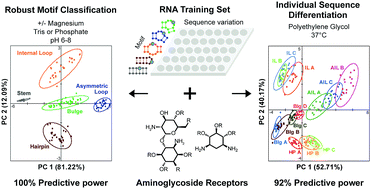
Chem. Commun., 2017,53, 13363-13366
https://doi.org/10.1039/C7CC07157D
Dimension-controlled assemblies of anion-responsive π-electronic systems bearing aryl substituents with fan-shaped geometries
Pyrrole-4-aryl-substituted dipyrrolyldiketone BF2 complexes showed fan-shaped and rod-shaped geometries for anion-free states and receptor–anion complexes, respectively, as building units of dimension-controlled assemblies.
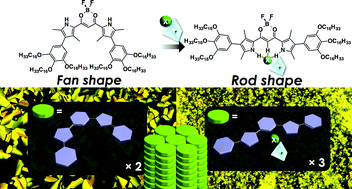
Chem. Commun., 2017,53, 3834-3837
https://doi.org/10.1039/C7CC01551H
Controlled assembly of organic whispering-gallery-mode microlasers as highly sensitive chemical vapor sensors
Organic whispering-gallery-mode lasers, assembled from π-conjugated polymers, can be used for highly sensitive detection of trace amounts of chemical gases by monitoring the shift of the lasing mode, paving a new way to design novel photonic sensing devices.

Chem. Commun., 2017,53, 3102-3105
https://doi.org/10.1039/C6CC08094D
Template-free hierarchical self-assembly of a pyrene derivative into supramolecular nanorods
A pyrene derivative was designed to form, through a hierarchical process, well-defined supramolecular nanorods.
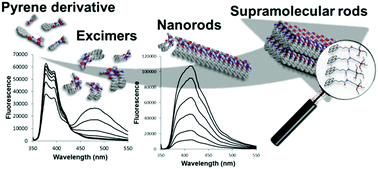
Chem. Commun., 2017,53, 1973-1976
https://doi.org/10.1039/C6CC09731F
The synergistic effect between KLVFF and self-assembly chaperones on both disaggregation of beta-amyloid fibrils and reducing consequent toxicity
A new synergistic system combining KLVFF peptide and self-assembly chaperone can synchronize disaggregating amyloid fibrils and reducing consequent toxicity.

Chem. Commun., 2017,53, 1289-1292
https://doi.org/10.1039/C6CC07803F
Carbodiimide insertion into sulfonimides: one-step route to azepine derivatives via a two-atom saccharin ring expansion
A novel carbodiimide insertion reaction enables a one-step, two-atom expansion of cyclic and linear sulfonimides, including the first direct expansion of saccharin into thiadiazepines.
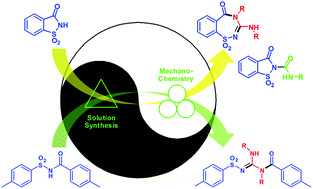
Chem. Commun., 2017,53, 901-904
https://doi.org/10.1039/C6CC07331J
Core expansion of bis-calix[4]arene-supported clusters
Stoichiometric control allows for remarkable expansion of the cores of two known bis-calix[4]arene-supported clusters, with concomitant changes to the magnetic properties.
![Graphical abstract: Core expansion of bis-calix[4]arene-supported clusters](/is/Image/Get?imageInfo.ImageType=GA&imageInfo.ImageIdentifier.ManuscriptID=C6CC08059F&imageInfo.ImageIdentifier.Year=2016)
Chem. Commun., 2016,52, 14246-14249
https://doi.org/10.1039/C6CC08059F
Imaging plasma membrane phase behaviour in live cells using a thiophene-based molecular rotor
A thiophene-based molecular rotor was used to probe ordering and viscosity within artificial lipid bilayers and live cell plasma membranes.
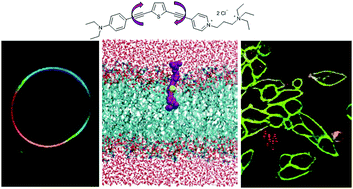
Chem. Commun., 2016,52, 13269-13272
https://doi.org/10.1039/C6CC05954F
Ship in a breakable bottle: fluoride-induced release of an organic molecule from a Pr(III)-linked molecular cage
A 3-dimensional networked molecular cage, NMC-1, has been synthesized that acts like a ‘molecular ship’ in a ‘breakable bottle’.
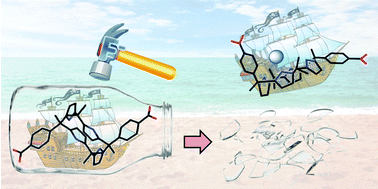
Chem. Commun., 2016,52, 8514-8517
https://doi.org/10.1039/C6CC03471C
β-Perfluoroalkyl-substituted pyrrole as an anion-responsive π-electronic system through a single NH moiety
A pyrrole derivative possessing two perfluorohexyl (C6F13) chains at the β-positions was synthesized. The significant electron-withdrawing properties of the β-perfluoroalkyl chains induced fascinating anion-binding behaviour.
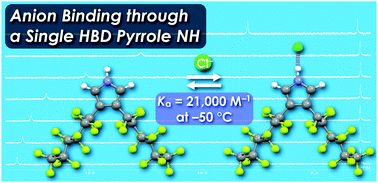
Chem. Commun., 2016,52, 7364-7367
https://doi.org/10.1039/C6CC03619H
Dimension-controlled assemblies of modified bipyrroles stabilized by electron-withdrawing moieties
Benzoyl-substituted bipyrroles possessing aliphatic chains were synthesized and formed a variety of dimension-controlled assembled structures as mesophases using various intermolecular interactions.

Chem. Commun., 2016,52, 7157-7160
https://doi.org/10.1039/C6CC03423C
Flow-dependent separation selectivity for organic molecules on metal–organic frameworks containing adsorbents
A new effect was discovered which allows changes of selectivity by variation of the mobile phase flow rate.

Chem. Commun., 2016,52, 5301-5304
https://doi.org/10.1039/C6CC00111D
In situ monitoring of vapour-induced assembly of pharmaceutical cocrystals using a benchtop powder X-ray diffractometer
We describe a simple setup for in situ continuous monitoring of vapour-induced transformations of organic solids using a benchtop powder X-ray diffractometer.

Chem. Commun., 2016,52, 5120-5123
https://doi.org/10.1039/C6CC01583B
One-step ligand exchange and switching from hydrophobic to water-stable hydrophilic superparamagnetic iron oxide nanoparticles by mechanochemical milling
Mechanochemistry permits rapid solvent-free exchange of surface ligands on superparamagnetic iron oxide nanoparticles (IONPs), enabling control of surface properties.

Chem. Commun., 2016,52, 3054-3057
https://doi.org/10.1039/C5CC07107K
Mechanochemical and solvent-free assembly of zirconium-based metal–organic frameworks
Mechanochemistry and accelerated aging are new routes to zirconium metal–organic frameworks, yielding UiO-66 and catalytically active UiO-66-NH2 accessible on the gram scale through mild solid-state self-assembly, without strong acids, high temperatures or excess reactants.

Chem. Commun., 2016,52, 2133-2136
https://doi.org/10.1039/C5CC08972G
Dipyrrolyphenol as a precursor of π-electronic anion that forms ion pairs with cations
A nitro-substituted dipyrrolylphenol was synthesized as a precursor of a π-electronic anion, whose phenolate (phenoxide) moiety upon deprotonation was stabilized by the hydrogen-bond-donating pyrrole NH, thus forming solid-state ion pairs with various cationic species.
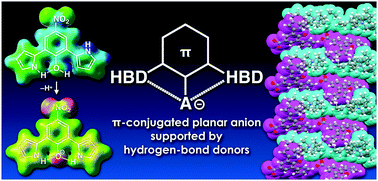
Chem. Commun., 2015,51, 17572-17575
https://doi.org/10.1039/C5CC07493B
Tuning the cavities of zirconium-based MIL-140 frameworks to modulate CO2 adsorption
A combined experimental and computational study on the CO2 adsorption performance of zirconium-based MIL-140 frameworks has revealed the crucial influence of pore-confinement effects.

Chem. Commun., 2015,51, 11286-11289
https://doi.org/10.1039/C5CC02539G
A FRET-based ratiometric redox probe for detecting oxidative stress by confocal microscopy, FLIM and flow cytometry
A FRET-based, ratiometric redox probe undergoes a fluorescence colour change upon reduction, and can be used to study cellular oxidative capacity using confocal microscopy, fluorescence lifetime imaging and flow cytometry.

Chem. Commun., 2015,51, 10510-10513
https://doi.org/10.1039/C5CC03394B
Fluorescent sensing of monofunctional platinum species
A fluorescein derivative exhibits increased fluorescence selectively in response to monofunctional platinum complexes, and can be used to study the metabolism of platinum-based chemotherapeutics.

Chem. Commun., 2015,51, 6312-6314
https://doi.org/10.1039/C4CC08077G
A dual-boron-cored luminogen capable of sensing and imaging
A new dual-boron-cored luminogen ligated with a nitrogen-containing multidentate ligand and four bulky phenyl rings exhibits AIE and piezochromism. Furthermore, it shows good capabilities for imaging and anion sensing.
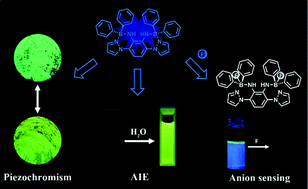
Chem. Commun., 2015,51, 5298-5301
https://doi.org/10.1039/C4CC08551E
Thiazolothiazole-linked porous organic polymers
Thiazolothiazole-linked porous organic polymers have been synthesized from a facile catalyst-free condensation reaction between aldehydes and dithiooxamide under solvothermal conditions.

Chem. Commun., 2014,50, 15055-15058
https://doi.org/10.1039/C4CC07255C
Highly unusual interpenetration isomers of electroactive nickel bis(dithiolene) coordination frameworks
Two highly unusual isomeric coordination frameworks incorporating the nickel bis(dithiolate) metalloligand exhibit cyclable electroactive properties.
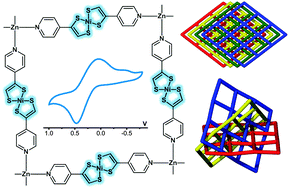
Chem. Commun., 2014,50, 12772-12774
https://doi.org/10.1039/C4CC05438E
Cyclotrimerization of arylalkynes on Au(111)
Cyclotrimerization of arylalkynes on Au(111) proceeds readily at modest temperatures, and affords two-dimensional covalently bonded polyphenylene networks.
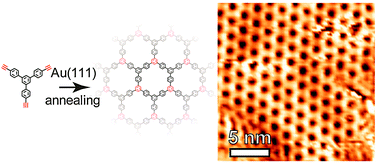
Chem. Commun., 2014,50, 11200-11203
https://doi.org/10.1039/C4CC02859G
Potential-driven molecular tiling of a charged polycyclic aromatic compound
Electrochemical potential causes molecular tiling of organic ions at the solid–liquid interface with supramolecular motifs that contain between 2 and 7 tectons.
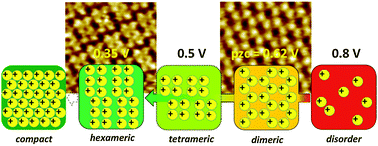
Chem. Commun., 2014,50, 10376-10378
https://doi.org/10.1039/C4CC04189E
A novel flavin derivative reveals the impact of glucose on oxidative stress in adipocytes
A fluorescent sensor for redox state shows reversible oxidation/reduction at biologically-relevant potentials, and is used to visualise cellular oxidative capacity.

Chem. Commun., 2014,50, 8181-8184
https://doi.org/10.1039/C4CC03464C
Synthesis of the 6,6,5,7-tetracyclic core of daphnilongeranin B
An efficient approach toward the synthesis of the 6,6,5,7-tetracyclic core of the daphnilongeranin B, a Daphniphyllum alkaloid, is reported.
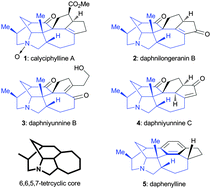
Chem. Commun., 2014,50, 5294-5297
https://doi.org/10.1039/C3CC47873D
A molecular rotor for measuring viscosity in plasma membranes of live cells
We report the viscosity imaging of the plasma membrane of live cells using a new targeted BODIPY-based molecular rotor.

Chem. Commun., 2014,50, 5282-5284
https://doi.org/10.1039/C3CC47530A
Structural alteration of the metal–organic pyrogallol[4]arene nano-capsule motif by incorporation of large metal centres
Addition of cadmium(II) nitrate to gallium-coordinated metal–organic C-alkylpyrogallol[4]arene nano-capsules affords a marked variation in the near spherical capsule motif.
![Graphical abstract: Structural alteration of the metal–organic pyrogallol[4]arene nano-capsule motif by incorporation of large metal centres](/is/Image/Get?imageInfo.ImageType=GA&imageInfo.ImageIdentifier.ManuscriptID=C4CC00202D&imageInfo.ImageIdentifier.Year=2014)
Chem. Commun., 2014,50, 4508-4510
https://doi.org/10.1039/C4CC00202D
Discovering the pivotal role of carbonate in the formation of a bis-phenolate supported Co15 cluster
The synthesis of a Co15 cluster is dependent on the in situ formation of CO32− and bis-phenolate ligands mimicking tetrahomodioxacalix[4]arene.

Chem. Commun., 2014,50, 2202-2204
https://doi.org/10.1039/C4CC00167B
Programmed hydrolysis of nanoassemblies by electrostatic interaction-mediated enzymatic-degradation
At physiological pH, polymer nanoparticles having degradable-core and charged-shell morphologies readily attract or repel enzymes carrying opposite or similar charges, respectively.

Chem. Commun., 2014,50, 968-970
https://doi.org/10.1039/C3CC46013D
A bis-phenolate for the construction of linear lanthanide trimers
The ligand bis(5-tert-butyl-2-hydroxy-3-hydroxymethyl-phenyl)methane, a flexible calix[n]arene analogue, is employed to construct an unusual linear [Ln3] trimer.
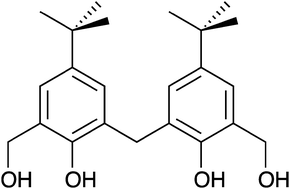
Chem. Commun., 2013,49, 9552-9554
https://doi.org/10.1039/C3CC44996C
Molecular sensing and discrimination by a luminescent terbium–phosphine oxide coordination material
PCM-15 is a robust and recyclable sensor for the effective discrimination of a wide range of small molecules.
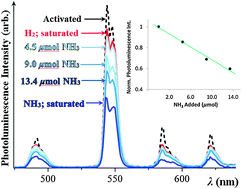
Chem. Commun., 2013,49, 7156-7158
https://doi.org/10.1039/C3CC44575E
Mesoporous anatase TiO2 nanocups with plasmonic metal decoration for highly active visible-light photocatalysis
This communication describes the facile synthesis of mesoporous cuplike anatase TiO2 nanocrystals. The novel cuplike morphology of the Au–TiO2 nanomaterial with a dominant (101) facet shows remarkable visible-light photoactivity.

Chem. Commun., 2013,49, 5817-5819
https://doi.org/10.1039/C3CC42029A
Microwave synthesis of Au–Rh core–shell nanoparticles and implications of the shell thickness in hydrogenation catalysis
A microwave-assisted heating method allows for the convenient and reproducible synthesis of defined Au–Rh core–shell metallic nanoparticles with tuneable shell thicknesses.

Chem. Commun., 2013,49, 4241-4243
https://doi.org/10.1039/C3CC40387D
Redox active aluminium(III) complexes convert CO2 into MgCO3 or CaCO3 in a synthetic cycle using Mg or Ca metal
Using concomitant redox and acid–base reactivity, conversion of CO2 into MgCO3 or CaCO3, via regenerable (IP−)2Al(OH), is presented (IP = α-iminopyridine).

Chem. Commun., 2013,49, 4175-4177
https://doi.org/10.1039/C2CC37208H
Microwave-assisted solvothermal synthesis of zirconium oxide based metal–organic frameworks
A highly efficient microwave methodology for the synthesis of isoreticular zirconium oxide based Metal–Organic Frameworks has been demonstrated.

Chem. Commun., 2013,49, 3706-3708
https://doi.org/10.1039/C3CC40368H
Two-photon fluorescent microporous bithiophene polymer via Suzuki cross-coupling
A two-photon fluorescent microporous bithiophene polymer (MBP) stable up to 460 °C was synthesized through Suzuki cross-coupling reaction.

Chem. Commun., 2012,48, 9519-9521
https://doi.org/10.1039/C2CC34535H
Controlling growth of molecular crystal aggregates for efficient optical waveguides
Well-defined microrods with controllable crystal aggregate structures were achieved to generate outstanding optical waveguide properties.

Chem. Commun., 2012,48, 9011-9013
https://doi.org/10.1039/C2CC32501B
A selective reaction-based fluorescent probe for detecting cobalt in living cells
A reaction-based strategy exploiting cobalt-mediated oxidative C–O bond cleavage affords a selective turn-on fluorescent probe for paramagnetic Co2+ in water and in living cells.
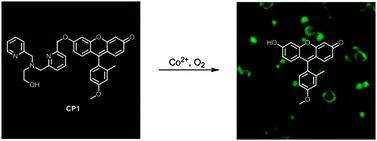
Chem. Commun., 2012,48, 5268-5270
https://doi.org/10.1039/C2CC31681A
Efficient synthesis and physical properties of novel H-shaped 2,3,7,8-tetraazaanthracene-based conjugated molecules
A new family of N-heteroacenes has been synthesized. Their solid state packing and optoelectronic properties can be finely tuned via modification of the substituents.
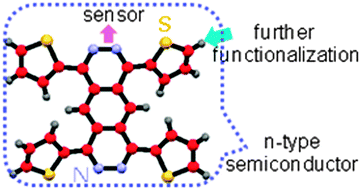
Chem. Commun., 2012,48, 4166-4168
https://doi.org/10.1039/C2CC00015F
Rapid determination of the optical and redox properties of a metal–organic framework via in situ solid state spectroelectrochemistry
The development of an in situ solid state UV-Vis-NIR technique reveals the optical properties of [Zn2(NDC)2(DPNI)]0/−/2− (DPNI = N,N′-di(4-pyridyl)-1,4,5,8-naphthalenetetracarboxydiimide, NDC = 2,7-naphthalene dicarboxylate).
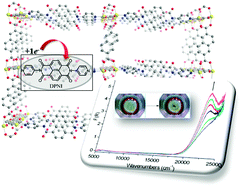
Chem. Commun., 2012,48, 3945-3947
https://doi.org/10.1039/C2CC30568B
Electrogenerated upconverted emission from doped organic nanowires
The electrogenerated upconversion was achieved in the uniformly doped organic nanowires based on triplet energy transfer from tris(2,2′-bipyridyl)ruthenium(II) to 9,10-diphenylanthracene.

Chem. Commun., 2012,48, 85-87
https://doi.org/10.1039/C1CC15632B
A coordination polymer of (Ph3P)AuCl prepared by post-synthetic modification and its application in 1-hexene /n-hexane separation
The 3-dimensional porous coordination polymer, PCM-10, is based on triphenylphosphine. The free phosphine sites within the polymer may be post-synthetically modified with catalytic species, such as AuCl.

Chem. Commun., 2011,47, 11855-11857
https://doi.org/10.1039/C1CC14682C
Simple routes to bulky silyl -substituted acetylide ligands and examples of V(III), Fe(II), and Mn(II) complexes
Synthesis of substituted phenylacetylide ligands 2,6-bis(trimethylsilyl)phenylacetylene (H1) and 2-(triphenylsilyl)phenylacteylene (H2) is reported.

Chem. Commun., 2011,47, 11680-11682
https://doi.org/10.1039/C1CC14758G
High capacity CO2 adsorption in a Mg(II)-based phosphine oxide coordination material
PCM-11: a highly stable Mg(II)-phosphine oxide coordination material that exhibits a very large CO2 storage capacity at high pressure.
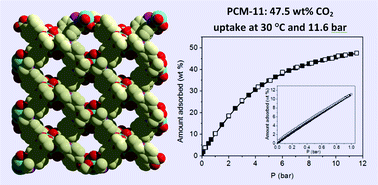
Chem. Commun., 2011,47, 4899-4901
https://doi.org/10.1039/C1CC10754B
Reactive oxygen species in photochemistry of the red fluorescent protein “Killer Red”
Using fluorescent probes and EPR we have shown that irradiation of “Killer Red” (KRed) results in the production of radicals and hydrogen peroxide supporting a Type I photosensitization mechanism.
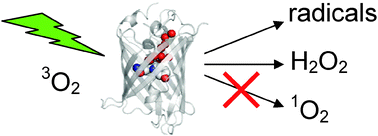
Chem. Commun., 2011,47, 4887-4889
https://doi.org/10.1039/C0CC05713D
Hydrogen evolution by cobalt tetraimine catalysts adsorbed on electrode surfaces
Tetraimine cobalt complexes are active for H2 evolution. A carboxylic acid derivative is electrochemically active in CH3CN upon adsorption to ITO. Co(dmgBF2)2(MeCN)2 (dmg = dimethylglyoxime) can be adsorbed on a glassy carbon electrode and is active for H2 evolution in aqueous solution at pH < 4.5 with an overpotential of ca. 100 mV.

Chem. Commun., 2010,46, 398-400
https://doi.org/10.1039/B921559J
Redox rich dicobalt macrocycles as templates for multi-electron transformations
Zwitterionic dinuclear cobalt macrocycles incorporating a pyridazine bridging unit reversibly support five distinct oxidation states, and are active proton reduction electrocatalysts at comparatively positive redox couples and low overpotentials.
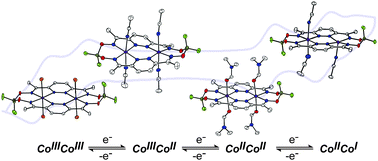
Chem. Commun., 2009, 6729-6731
https://doi.org/10.1039/B913946J
Stabilisation of a heptamethine cyanine dye by rotaxane encapsulation
A cyclodextrin is clasped round the waist of a cyanine dye to form a stable rotaxane.

Chem. Commun., 2008, 2897-2899
https://doi.org/10.1039/B802728E
Monitoring the effect of ultrafast deactivation of the electronic excited states of DNA bases and polynucleotides following 267 nm laser excitation using picosecond time-resolved infrared spectroscopy
A picosecond infrared spectroscopic study of DNA bases has demonstrated that electronic excitation creates vibrationally excited ground state molecules within the first picosecond.

Chem. Commun., 2005, 1182-1184
https://doi.org/10.1039/B414450C
About this collection
We are delighted to present a collection showcasing articles by winners of the ChemComm Emerging Investigator Lectureship over the years. This Lectureship recognises outstanding early-career scientists who have made a significant contribution in their research field.
Our 2019 winners are Raffaella Buonsanti (EPFL) and Corinna Schindler (University of Michigan).
Raffaella obtained her PhD in Nanochemistry in 2010 at the National Nanotechnology Laboratory, University of Salento. Afterwards, she moved to the US where she spent over five years at the Lawrence Berkeley National Laboratory, first as a postdoc and project scientist at the Molecular Foundry and after as a tenure-track staff scientist in the Joint Center for Artificial Photosynthesis. She is currently a tenure-track Assistant Professor in the Institute of Chemical Sciences and Engineering at EPFL in Switzerland. Her group works at the interface of materials chemistry and catalysis, using colloidal chemistry tools to synthesize controlled and tunable nanocrystals and to advance the current knowledge on the electrocatalytic conversion of small molecules into value-added chemicals.
Corinna was awarded her PhD in 2010 at the ETH Zurich, where she worked with Professor Erick M. Carreira on the total synthesis of Banyaside B and Microcin SF608. She has been awarded several honors during her independent career, including a 2016 David and Lucile Packard Foundation Fellowship, a 2016 NSF CAREER award, a 2018 Alfred P. Sloan Research Fellowship, a 2018 Camille Dreyfus Teacher-Scholar Award, a 2019 Marion Milligan Mason Award, and a 2019 Presidential Early Career Award for Scientists and Engineers. She is currently an Assistant Professor at the University of Michigan, Ann Arbor and her group’s research focuses on the development of new synthetic transformations relying on environmentally benign metals and the synthesis of complex molecules of biological importance in cancer treatment and infectious diseases.
This collection highlights ChemComm articles by Raffaella and Corinna, and our previous winners: Amanda Hargrove (Duke University), Alexander Miller (University of North Carolina), Elizabeth New (University of Sydney), Ang Li (Shanghai Institute of Organic Chemistry), Deanna D’Alessandro (University of Sydney), Yong Sheng Zhao (Beijing National Laboratory for Molecular Sciences), Xinliang Feng (Max Planck Institute for Polymer Research), Tomislav Friščić (McGill University), Simon M. Humphrey (University of Texas at Austin), Louise A. Berben (University of California at Davis), Marina Kuimova (Imperial College), Hiromitsu Maeda (Ritsumeikan University), Scott Dalgarno (Heriot-Watt University).